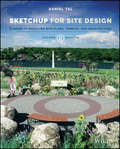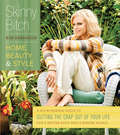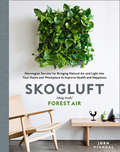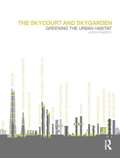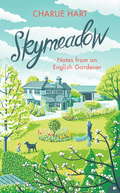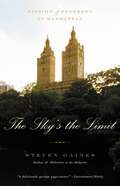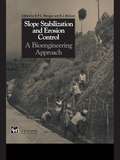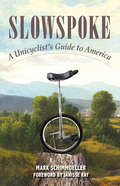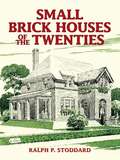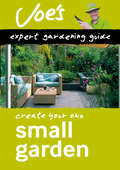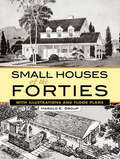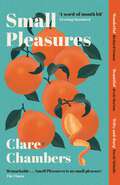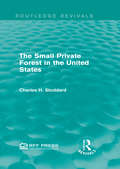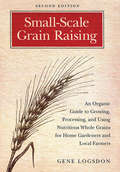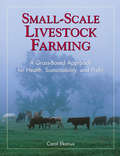- Table View
- List View
SketchUp for Site Design: A Guide to Modeling Site Plans, Terrain, and Architecture
by Daniel TalThe site designer's guide to SketchUp's powerful modeling capabilities SketchUp for Site Design is the definitive guide to SketchUp for landscape architects and other site design professionals. Step-by-step tutorials walk you through basic to advanced processes, with expert guidance toward best practices, customization, organization, and presentation. This new second edition has been revised to align with the latest software updates, with detailed instruction on using the newest terrain modeling tools and the newly available extensions and plug-ins. All graphics have been updated to reflect the current SketchUp interface and menus, and the third part of the book includes all-new content featuring the use of new grade and terrain extensions. Developed around the needs of intermediate professional users and their workflows, this book provides practical all-around coaching on using SketchUp specifically for modeling site plans. SketchUp was designed for usability, with the needs of the architect, industrial designer, and engineers at center stage. This book shows you how the software's powerful terrain and grade functions make it an ideal tool for site designers, and how to seamlessly integrate it into your workflow for more efficient design and comprehensive planning. Master the SketchUp basics, navigation, components, and scripts Turn 2D sketches into 3D models with volume, color, and material Create detailed site plans, custom furnishings, gradings, and architecture Learn sandbox tools, organization strategies, and model presentation tips SketchUp has undergone major changes since the publication of this guide's first edition, with its sale to Trimble Navigation bringing about a number of revisions and the availability of more immediately useful features. SketchUp for Site Design shows you how to harness the power of this newly expanded feature set to smooth and optimize the site design workflow.
Skinny Bitch: A No-Nonsense Guide to Cutting the Crap Out of Your Life for a Better Body and a Kinder World
by Kim BarnouinKim Barnouin has already told her fans how to "stop eating crap and start looking fabulous." But there's more to being a Skinny Bitch than eating well. Turns out, there's crap everywhere-not just in food, but in cosmetics, clothing, and home furnishings. Kim blows the lid on all of the nasties in our everyday stuff (everything from lipstick to sofa upholstery), and shows how we can make both small and big changes in our home, wardrobe, and beauty regimen-for living the Ultimate Skinny Bitch lifestyle!
Skinny Bitch: A No-Nonsense Guide to Cutting the Crap Out of Your Life for a Better Body and a Kinder World
by Kim BarnouinKim Barnouin has already told her fans how to "stop eating crap and start looking fabulous." But there's more to being a Skinny Bitch than eating well. Turns out, there's crap everywhere -- not just in food, but in cosmetics, clothing, and home furnishings. Kim blows the lid on all of the nasties in our everyday stuff (everything from lipstick to sofa upholstery), and shows how we can make both small and big changes in our home, wardrobe, and beauty regimen -- for living the Ultimate Skinny Bitch lifestyle!
Skittles or ninepins (large print)
by RnibThere are two images on this page: three skittles seen from the side and nine skittles with a ball seen from above. Both images have a dashed line image border. There is a locator dot shown, which will be at the top left of the page when the image is the correct way up. On the left of the page, you can find the picture of three skittles standing on a brown wooden floor. They are coloured yellow, and each one has a blue stripe on its round top and two red stripes on the bottom. There is a small red bit on the top of the skittle in the middle showing that it is the kingpin or redtop. This is put in the middle of the group of nine. The picture of nine skittles is on the right of the page. The skittles are at the top of the image and the blue ball is at the bottom. There are two arrows pointing up and left from the ball showing which way it is travelling. The kingpin, in the middle of the group, has a red bit on its top; extra points are scored if you can leave this one standing while knocking over the rest.
Skittles or ninepins (UEB contracted)
by RnibThere are two images on this page: three skittles seen from the side and nine skittles with a ball seen from above. Both images have a dashed line image border. There is a locator dot shown, which will be at the top left of the page when the image is the correct way up. On the left of the page, you can find the picture of three skittles standing on a brown wooden floor. They are coloured yellow, and each one has a blue stripe on its round top and two red stripes on the bottom. There is a small red bit on the top of the skittle in the middle showing that it is the kingpin or redtop. This is put in the middle of the group of nine. The picture of nine skittles is on the right of the page. The skittles are at the top of the image and the blue ball is at the bottom. There are two arrows pointing up and left from the ball showing which way it is travelling. The kingpin, in the middle of the group, has a red bit on its top; extra points are scored if you can leave this one standing while knocking over the rest.
Skittles or ninepins (UEB uncontracted)
by RnibThere are two images on this page: three skittles seen from the side and nine skittles with a ball seen from above. Both images have a dashed line image border. There is a locator dot shown, which will be at the top left of the page when the image is the correct way up. On the left of the page, you can find the picture of three skittles standing on a brown wooden floor. They are coloured yellow, and each one has a blue stripe on its round top and two red stripes on the bottom. There is a small red bit on the top of the skittle in the middle showing that it is the kingpin or redtop. This is put in the middle of the group of nine. The picture of nine skittles is on the right of the page. The skittles are at the top of the image and the blue ball is at the bottom. There are two arrows pointing up and left from the ball showing which way it is travelling. The kingpin, in the middle of the group, has a red bit on its top; extra points are scored if you can leave this one standing while knocking over the rest.
Skogluft (Forest Air) (Forest Air) (Forest Air) (Forest Air): The Norwegian Secret to Bringing the Right Plants Indoors to Improve Your Health and Happiness: The Norwegian Secret To Using Plants To Dramatically Improve Health And Happiness
by Jorn ViumdalWhy do we spend so much time indoors, which is not our natural habitat? Why have trends such as forest-bathing become so popular? The answer to the last question lies in the proven benefits we obtain from our connection with nature – from increased productivity to feelings of happiness and an enhanced sense of wellbeing.
Skoolie!: How to Convert a School Bus or Van into a Tiny Home or Recreational Vehicle
by Will SutherlandThis complete guide to turning a school bus into a tiny house brings the dream of a nomadic life and a cozy home on wheels within reach — and within budget — featuring how-to photos along with creative layout ideas and profiles of skoolie fanatics.
The Skycourt and Skygarden: Greening the urban habitat
by Jason PomeroyPopulation increases, advances in technology and the continued trend towards inner-city migration have transformed the traditional city of spaces into the modern city of objects. This has necessitated alternative spatial and technological solutions to replenish those environments that were once so intrinsic to society’s day-to-day interactions and communal activities. This book considers skycourts and skygardens as ‘alternative social spaces’ that form part of a broader multi-level urban infrastructure – seeking to make good the loss of open space within the built environment. Jason Pomeroy begins the discussion with the decline of the public realm, and how the semi-public realm has been incorporated into a spatial hierarchy that supports the primary figurative spaces on the ground or, in their absence, creates them in the sky. He then considers skycourts and skygardens in terms of the social, cultural, economic, environmental, technological and spatial benefits that they provide to the urban habitat. Pomeroy concludes by advocating a new hybrid that can harness the social characteristics of the public domain, but be placed within buildings as an alternative communal space for the 21st century. Using graphics and full colour images throughout, the author explores 40 current and forthcoming skycourt and skygarden projects from around the world, including the Shard (London), Marina Bay Sands (Singapore), the Shanghai Tower (China) and the Lotte Tower (South Korea).
The Skycourt and Skygarden: Greening the urban habitat
by Jason PomeroyPopulation increases, advances in technology and the continued trend towards inner-city migration have transformed the traditional city of spaces into the modern city of objects. This has necessitated alternative spatial and technological solutions to replenish those environments that were once so intrinsic to society’s day-to-day interactions and communal activities. This book considers skycourts and skygardens as ‘alternative social spaces’ that form part of a broader multi-level urban infrastructure – seeking to make good the loss of open space within the built environment. Jason Pomeroy begins the discussion with the decline of the public realm, and how the semi-public realm has been incorporated into a spatial hierarchy that supports the primary figurative spaces on the ground or, in their absence, creates them in the sky. He then considers skycourts and skygardens in terms of the social, cultural, economic, environmental, technological and spatial benefits that they provide to the urban habitat. Pomeroy concludes by advocating a new hybrid that can harness the social characteristics of the public domain, but be placed within buildings as an alternative communal space for the 21st century. Using graphics and full colour images throughout, the author explores 40 current and forthcoming skycourt and skygarden projects from around the world, including the Shard (London), Marina Bay Sands (Singapore), the Shanghai Tower (China) and the Lotte Tower (South Korea).
Skymeadow: Notes from an English Gardener
by Charlie Hart'A love letter to English horticulture written by a passionate gardener. A must-read for anyone who has dreamt of cultivating their own patch of land' Jane Perrone'Skymeadow is a fascinating book . . . Every flower, every passing bud, every change in the season is described with rapture' Jilly CooperWhen Charlie Hart first visited Peverels, a small farmhouse that sits lazily on the lip of a hill running down into the Peb Valley, he was at breaking point, grieving the loss of his father and anxious about the impending death of his mother. He and his wife Sybilla felt that their London life had been steadily growing in noise: the noise of grief, the noise of busyness, the noise that comes from the expectations of others and, for Charlie, the constant clamour of dissatisfaction at work. At Peverels, Charlie found an expanse of untouched meadowland, the perfect setting for an audacious garden. Charlie felt an unquenchable urge to dig, to create something. The days he spent wrestling with the soil in the rose garden were the days in which he mourned the loss of his parents. Gardening has taught him that you can dig for victory, but you can also dig for mental health. As the garden formed around Charlie, he buried his fears and anxieties within it. A garden that is now known as Skymeadow and grows with a lusty, almost biblical vigour.In Skymeadow, Charlie seamlessly weaves together his own memoir with that of his garden. The result is a lyrical and incisive story of mental health at an all-time low, the healing powers of digging and, ultimately, a celebration of nature.
The Sky's the Limit: Passion and Property in Manhattan
by Steven GainesWith his signature elan, Gaines weaves a gossipy tapestry of brokers, buyers, co-op boards, and eccentric landlords and tells of the apartment hunting and renovating adventures of many celebrities -- from Tommy Hilfiger to Donna Karan, from Jerry Seinfeld to Steven Spielberg, from Barbra Streisand to Madonna. Gaines uncovers the secretive, unwritten rules of co-op boards: why diplomats and pretty divorcees are frowned upon, what not to wear to a board interview, and which of the biggest celebrities and CEOs have been turned away from the elite buildings of Fifth and Park Avenues. He introduces the carriage-trade brokers who never have to advertise for clients and gives us finely etched portraits of a few of the discreet, elderly society ladies who decide who gets into the so-called Good Buildings. Here, too, is a fascinating chronicle of the changes in Manhattan's residential skyline, from the slums of the nineteenth century to the advent of the luxury building. Gaines describes how living in boxes stacked on boxes came to be seen as the ultimate in status, and how the co-operative apartment, originally conceived as a form of housing for the poor, came to be used as a legal means of black-balling undesirable neighbors. A social history told through brick and mortar, The Sky's the Limit is the ultimate look inside one of the most exclusive and expensive enclaves in the world, and at the lengths to which people will go to get in.
Slope Stabilization and Erosion Control: A Bioengineering Approach
by Roy P.C. Morgan R.J. RicksonThis book is an up-to-date review of research and practice on the use of vegetation for slope stabilization and control of surface erosion caused by water and wind. From a basic understanding of the principles and practices of vegetation growth and establishment, it describes how vegetation can be treated as an engineering material and used to solve erosion and slope stability problems.
Slope Stabilization and Erosion Control: A Bioengineering Approach
by Roy P.C. Morgan R.J. RicksonThis book is an up-to-date review of research and practice on the use of vegetation for slope stabilization and control of surface erosion caused by water and wind. From a basic understanding of the principles and practices of vegetation growth and establishment, it describes how vegetation can be treated as an engineering material and used to solve erosion and slope stability problems.
Slowspoke: A Unicyclist's Guide to America
by Mark SchimmoellerWhy a unicycle? Why a cross-country trip? Why leave a prominent New York magazine and return to the simple life in Kentucky? Reminiscent of classic literary travelogues, Mark Schimmoeller’s Slowspoke: A Unicyclist’s Guide to America takes readers on an inward, emotional journey as he inches across landscapes and communities from North Carolina to Arizona. Schimmoeller became inspired by his unicycle as an adolescent. It taught him that rushing—whether down the driveway or toward adulthood—would cause a fall, and so, instead of accepting the speeding, straight line that de-fines modern American life, he adopted his single wheel’s wayward rhythms. Written with poise and humor, Slowspoke is more than a cross-country trip on a unicycle; it’s a meditation on a playful, recalcitrant slowness that is increasingly rare in a culture obsessed with acceleration. At times ach-ing and other times joyful, Schimmoeller intersperses recollections of his journey with vignettes of his present-day, off-the-grid homesteading with his wife in Kentucky and their efforts to save an old-growth forest. Schimmoeller’s personal journey will resonate with anyone who has slowed down to experience life at a unicycle’s speed or who longs to do so, who has fallen in love or searched for it, or who has treasured tall trees or mourned their loss.
Small Brick Houses of the Twenties
by Ralph P. StoddardOnce affordable only among the wealthy, brick homes became more easily available to the average American in the early years of the twentieth century. This book, originally published in 1920 by a member of The Common Brick Manufacturers' Association, served as a practical guide for prospective homeowners from working class families. Many soon found that attractive, durable, and comfortable homes--made from nature's own building material--were easily within their financial reach. <p><p> Thirty-five sets of floor plans, elevations, and specifications in this excellent reproduction of that now-rare volume depict a wide variety of brick houses, bungalows, cottages, garages, and multi-dwelling buildings--from the four-bedroom Pocatello to the handsome Saratoga, featuring a wraparound porch and two bathrooms. This practical guide will appeal to anyone wanting to buy or renovate an existing home of the period. It will also serve as a how-to manual for all desiring to build their own homes today with authentic materials and techniques. For those who love fine, old buildings, Small Brick Houses of the Twenties offers a charming view of American homes from that era.
Small Cities with Big Dreams: Creative Placemaking and Branding Strategies
by Greg Richards Lian DuifHow can small cities make an impact in a globalizing world dominated by ‘world cities’ and urban development strategies aimed at increasing agglomeration? This book addresses the challenges of smaller cities trying to put themselves on the map, attract resources and initiate development. Placemaking has become an important tool for driving urban development that is sensitive to the needs of communities. This volume examines the development of creative placemaking practices that can help to link small cities to external networks, stimulate collaboration and help them make the most of the opportunities presented by the knowledge economy. The authors argue that the adoption of more strategic, holistic placemaking strategies that engage all stakeholders can be a successful alternative to copying bigger places. Drawing on a range of examples from around the world, they analyse small city development strategies and identify key success factors. This book focuses on the case of ‘s-Hertogenbosch, a small Dutch city that used cultural programming to link itself to global networks and stimulate economic, cultural, social and creative development. It advocates the use of cultural programming strategies as a more flexible alternative to traditional top-down planning approaches and as a means of avoiding copying the big city. The Open Access version of this book, available at http://www.taylorfrancis.com, has been made available under a Creative Commons Attribution-Non Commercial-No Derivatives (CC-BY-NC-ND) 4.0 license.
Small Cities with Big Dreams: Creative Placemaking and Branding Strategies
by Greg Richards Lian DuifHow can small cities make an impact in a globalizing world dominated by ‘world cities’ and urban development strategies aimed at increasing agglomeration? This book addresses the challenges of smaller cities trying to put themselves on the map, attract resources and initiate development. Placemaking has become an important tool for driving urban development that is sensitive to the needs of communities. This volume examines the development of creative placemaking practices that can help to link small cities to external networks, stimulate collaboration and help them make the most of the opportunities presented by the knowledge economy. The authors argue that the adoption of more strategic, holistic placemaking strategies that engage all stakeholders can be a successful alternative to copying bigger places. Drawing on a range of examples from around the world, they analyse small city development strategies and identify key success factors. This book focuses on the case of ‘s-Hertogenbosch, a small Dutch city that used cultural programming to link itself to global networks and stimulate economic, cultural, social and creative development. It advocates the use of cultural programming strategies as a more flexible alternative to traditional top-down planning approaches and as a means of avoiding copying the big city. The Open Access version of this book, available at http://www.taylorfrancis.com, has been made available under a Creative Commons Attribution-Non Commercial-No Derivatives (CC-BY-NC-ND) 4.0 license.
Small Garden: Create Your Own Green Space With This Expert Gardening Guide (Collins Gardening)
by Joe Swift Collins BooksCreate your own small garden with expert gardener Joe Swift. Green spaces are the perfect antidote to fast city living. Learn how to create your own small garden with expert gardener Joe Swift’s practical, easy-to-follow advice. From courtyards to rooftops, transform awkward and unexciting spaces with inspirational ideas and solutions.
Small Houses of the Forties: With Illustrations and Floor Plans
by Harold E. GroupDesigned for the 1940s family with a "limited budget but unlimited good taste," this fascinating volume presents 56 floor plans and elevations of lovely small homes that originally cost less than $15,000 to build. Each home, bearing the honorable designation of House-of-the-Month by the era's Monthly Small House Club, Inc., was designed to give prospective homeowners an exceptionally well-planned house that was also a sound investment. From Cape Cods to Colonials, Small Houses of the Forties offers an eden of illustrations of cozy, charming domiciles, complete with color combinations, charts, and diagrams. This complete republication of a now-rare volume is also filled with vintage dollars-and-sense information for the postwar homebuyer, including mortgage guidance, amortization schedules, valuations, and construction costs of the times. <p><p> A nostalgic flashback to a simpler American dream of white picket fences, this entertaining and valuable reference will delight architecture enthusiasts, plan collectors, restorers, and historians alike.
Small Pleasures: Longlisted for the Women's Prize for Fiction
by Clare ChambersLONGLISTED FOR THE WOMEN'S PRIZE FOR FICTION 2021'A WORD-OF-MOUTH HIT' Evening Standard 'A very fine book... It's witty and sharp and reads like something by Barbara Pym or Anita Brookner, without ever feeling like a pastiche'David Nicholls'Perfect'India Knight 'Beautiful' Jessie Burton'Wonderful'Richard Osman 'Miraculous'Tracy Chevalier 'A wonderful novel. I loved it'Nina Stibbe 'Effortless to read, but every sentence lingers in the mind' Lissa Evans 'This is one of the most beautiful books I have ever read. I honestly don't want you to be without it'Lucy Mangan'Gorgeous... If you're looking for something escapist and bittersweet, I could not recommend more' Pandora Sykes'Remarkable... Small Pleasures is no small pleasure'The Times'An irresistible novel - wry, perceptive and quietly devastating'Mail on Sunday'Chambers' eye for undemonstrative details achieves a Larkin-esque lucidity' Guardian'An almost flawlessly written tale of genuine, grown-up romantic anguish' The Sunday Times 1957, the suburbs of South East London. Jean Swinney is a journalist on a local paper, trapped in a life of duty and disappointment from which there is no likelihood of escape. When a young woman, Gretchen Tilbury, contacts the paper to claim that her daughter is the result of a virgin birth, it is down to Jean to discover whether she is a miracle or a fraud. As the investigation turns her quiet life inside out, Jean is suddenly given an unexpected chance at friendship, love and - possibly - happiness. But there will, inevitably, be a price to pay.Book of the Year for: The Times, Daily Telegraph, Evening Standard, Daily Express, Metro, Spectator, Red Magazine and Good Housekeeping
The Small Private Forest in the United States (Routledge Revivals)
by Charles H. StoddardThroughout the past few decades, the standard answer to the problem of low productivity in small private forests has been education. It has been assumed that the chief obstacle to "good" forestry has been lack of knowledge. But the stubborn persistence of the problem raises some doubts as to the efficacy of the remedy. In this book, first published in 1961, the author takes a sharper look at this problem. He tries to find out what has worked reasonably well, and what has not, and makes some suggestions as to what seems to offer the best prospects for the future. The Small Private Forest in the United States will be of interest to students of environmental studies, as well as to private landowners.
The Small Private Forest in the United States (Routledge Revivals)
by Charles H. StoddardThroughout the past few decades, the standard answer to the problem of low productivity in small private forests has been education. It has been assumed that the chief obstacle to "good" forestry has been lack of knowledge. But the stubborn persistence of the problem raises some doubts as to the efficacy of the remedy. In this book, first published in 1961, the author takes a sharper look at this problem. He tries to find out what has worked reasonably well, and what has not, and makes some suggestions as to what seems to offer the best prospects for the future. The Small Private Forest in the United States will be of interest to students of environmental studies, as well as to private landowners.
Small-Scale Grain Raising: An Organic Guide to Growing, Processing, and Using Nutritious Whole Grains for Home Gardeners and Local Farmers, 2nd Edition
by Gene Logsdon Jerry O'BrienFirst published in 1977, this book—from one of America’s most famous and prolific agricultural writers—became an almost instant classic among homestead gardeners and small farmers. Now fully updated and available once more, Small-Scale Grain Raising offers a entirely new generation of readers the best introduction to a wide range of both common and lesser-known specialty grains and related field crops, from corn, wheat, and rye to buckwheat, millet, rice, spelt, flax, and even beans and sunflowers. More and more Americans are seeking out locally grown foods, yet one of the real stumbling blocks to their efforts has been finding local sources for grains, which are grown mainly on large, distant corporate farms. At the same time, commodity prices for grains—and the products made from them—have skyrocketed due to rising energy costs and increased demand. In this book, Gene Logsdon proves that anyone who has access to a large garden or small farm can (and should) think outside the agribusiness box and learn to grow healthy whole grains or beans—the base of our culinary food pyramid—alongside their fruits and vegetables. Starting from the simple but revolutionary concept of the garden “pancake patch,” Logsdon opens up our eyes to a whole world of plants that we wrongly assume only the agricultural “big boys” can grow. He succinctly covers all the basics, from planting and dealing with pests, weeds, and diseases to harvesting, processing, storing, and using whole grains. There are even a few recipes sprinkled throughout, along with more than a little wit and wisdom. Never has there been a better time, or a more receptive audience, for this book. Localvores, serious home gardeners, CSA farmers, and whole-foods advocates—in fact, all people who value fresh, high-quality foods—will find a field full of information and ideas in this once and future classic.
Small-Scale Livestock Farming: A Grass-Based Approach for Health, Sustainability, and Profit
by Carol EkariusFull of practical everyday advice, this guide explains how a natural, organic approach to livestock farming produces healthy animals, reduces costs, and increases your operation&’s self-sufficiency. Livestock expert Carol Ekarius helps you create a viable farm plan, choose suitable livestock, care for your animals&’ health, and confidently manage housing, fencing, and feeding. Case studies of successful farmers provide inspiration as you learn everything you need to know to run a prosperous livestock farm and make the lifestyle of your dreams a reality. This publication conforms to the EPUB Accessibility specification at WCAG 2.0 Level AA.
